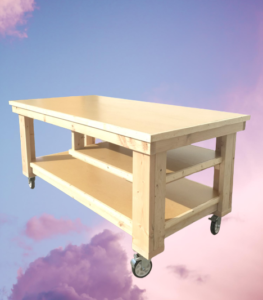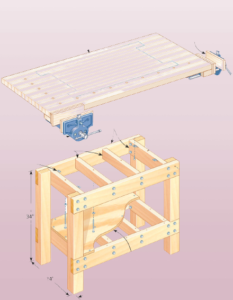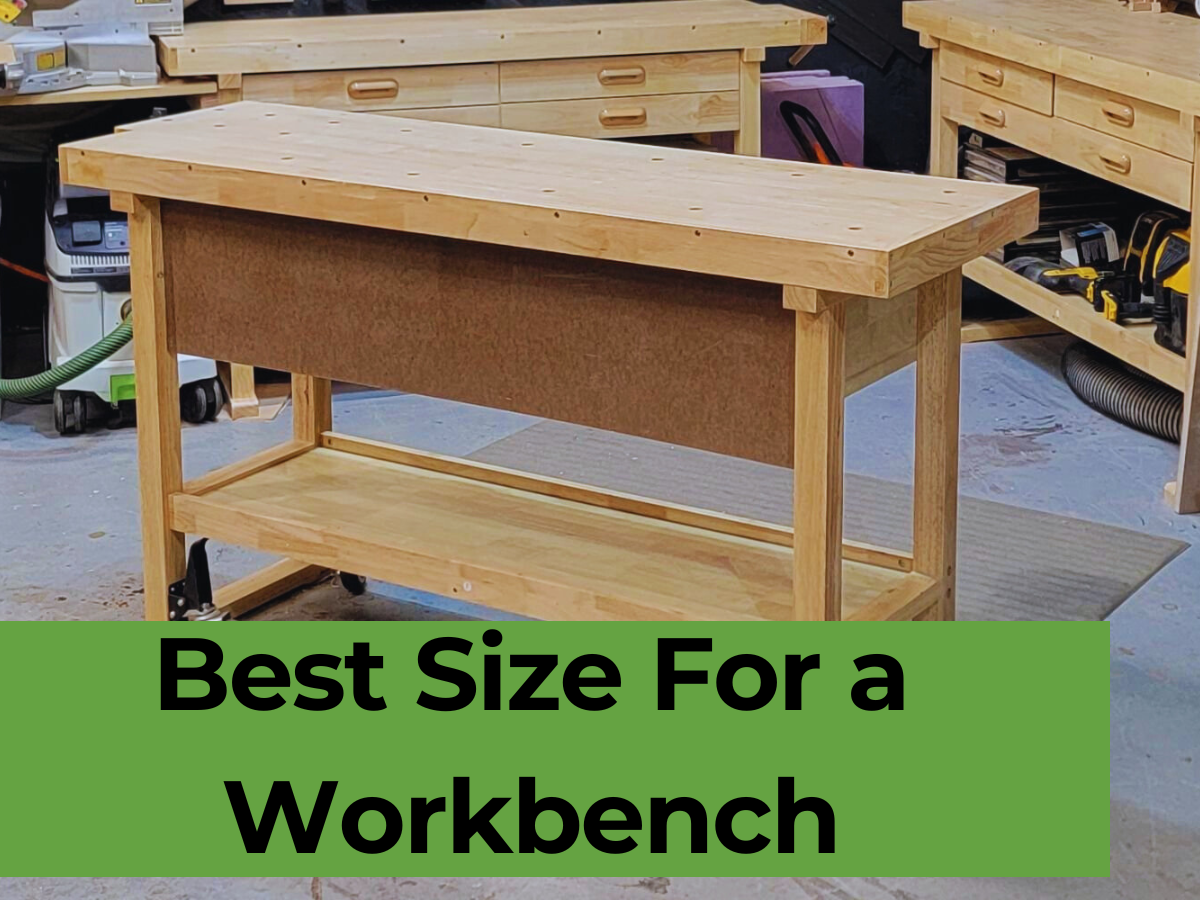Hey, I am James Brown, and welcome to my new article, where I will tell you The best size for a Workbench?
Having the right size workbench is crucial for woodworkers of all skill levels. It not only affects your comfort and productivity but also ensures that you can work on your projects effectively. In this article, we will delve into why having the right size workbench is important and discuss the key factors to consider when choosing the size of a workbench.
Why having the right size workbench is important
The size of your workbench plays a significant role in your overall woodworking experience. Here are a few reasons why having the right size workbench is important:
- Comfort: Working on a workbench that is too high or too low can lead to strain on your back, neck, and shoulders. Having a workbench at the right height ensures proper ergonomics, allowing you to work comfortably for extended periods without discomfort.
- Efficiency: A workbench that is too small may limit your workspace and make it difficult to maneuver your materials and tools. On the other hand, a workbench that is too large can lead to unnecessary bending or reaching, which can slow down your workflow. The right size workbench provides ample workspace while ensuring easy access to your tools and materials.
- Stability: A workbench that is too small or lightweight may lack stability, causing it to wobble or move while you work. This can be frustrating and even dangerous, especially when working with power tools or heavy materials. A properly sized workbench provides the stability needed to safely and securely complete your woodworking tasks.
Factors to consider when choosing the size of a workbench
When determining the size of your workbench, consider the following factors:
- Available space: Measure your workshop or designated work area to determine how much space you have available for a workbench. You want to choose a size that fits comfortably in your workspace without compromising maneuverability.
- Types of projects: Consider the size of the projects you typically work on. If you primarily work on smaller projects, a compact workbench might be suitable. However, if you often tackle larger projects, such as furniture pieces, a larger workbench with ample surface area is essential.
- Height: As mentioned earlier, the height of your workbench is crucial for your comfort and ergonomics. Consider your own height and working preferences when choosing the height of your workbench. Aim for a height that allows you to work comfortably without straining your back or arms.
- Storage needs: Think about the storage requirements for your tools and materials. If you have an extensive collection of tools and need ample storage space, consider a workbench with built-in drawers or shelves.
By considering these factors and choosing the right size workbench, you can create a harmonious workspace that enhances your woodworking experience and helps you achieve excellent results.
In the next section, we will explore some best examples of workbenches that showcase the ideal size and functionality. Stay tuned!
Small Workbenches

Advantages and disadvantages of small workbenches
Small workbenches have their own unique advantages and disadvantages that you should consider when deciding on the best size for your workspace. Here are some key points to keep in mind:
Advantages:
- Space-saving: Small workbenches are ideal for workshops or garages with limited space. They can easily fit into smaller areas without overcrowding the room, allowing you to maximize your available workspace.
- Portability: Smaller workbenches are generally lighter in weight and easier to move around, making them suitable for those who may need to relocate their workspace frequently. This portability can be particularly beneficial for those who work on-site or in shared workshop spaces.
- Affordability: Small workbenches are often more budget-friendly compared to larger ones. If you’re just starting out or have a limited budget, a smaller workbench can be a cost-effective choice.
Disadvantages:
- Restricted workspace: The main drawback of small workbenches is their limited surface area. This can make it challenging to work on larger or more complex projects that require more room for materials, tools, and movement.
- Lack of storage: Smaller workbenches may have fewer storage options compared to their larger counterparts. If you have a significant amount of tools or need ample storage space for materials and supplies, a small workbench might not be sufficient.
Recommended size range for small workbenches
Depending on your demands and space, a small workbench should be 30″ x 20″ to 48″ x 24″. This provides enough area for woodworking, handicraft, and minor repairs.
Consider the type of projects you will be working on before choosing a workbench size. Small ones may not fit larger power tools or equipment. Also, make sure the workbench is 36 inches high, which is suitable for working at.
We will discuss larger workbenches and their benefits for those who need more space in the next section. Stay tuned for additional workstation size tips!
Medium Workbenches
Advantages and disadvantages of medium workbenches
When it comes to workbenches, medium-sized options offer a balance between space-saving and functionality. Here are some advantages and disadvantages to consider:
Advantages:
- Versatility: Medium workbenches provide enough space to accommodate a range of projects, from small repairs to light woodworking. They offer more surface area compared to smaller workbenches, allowing for more flexibility in working with materials and tools.
- Storage options: Medium workbenches often come with built-in storage options such as drawers and shelves. This allows you to keep your tools, supplies, and materials organized and easily accessible.
- Stability: Medium workbenches tend to be more stable than smaller ones, providing a solid and reliable surface for your work. This can be particularly important when working with heavier materials or using power tools.
Disadvantages:
- Space requirements: The main drawback of medium workbenches is that they require a larger workspace. If you have limited space in your workshop or garage, a medium-sized workbench might not be the most practical choice.
- Mobility: Medium workbenches can be heavier and bulkier than smaller ones, making them less portable. If you need to frequently move or rearrange your workspace, a smaller or more portable option might be more suitable.
Recommended size range for medium workbenches
Medium workbenches tend to be 48″ x 24″ to 72″ x 30″. This accommodates many tasks and enables for comfortable mobility and work. Before choosing a size, consider your job and workshop space.
Make sure the workbench is the right height for you, usually 36 inches. This will make working pleasant and reduce back and shoulder strain.
We shall explore the pros and considerations of larger workbenches for people who need extra workspace in the next section. Stay tuned for additional workstation size tips!
Large Workbenches

Advantages and disadvantages of large workbenches
When it comes to workbenches, larger options provide ample workspace for projects that require extensive materials, tools, and equipment. Here are some advantages and disadvantages to consider:
Advantages:
- Spaciousness: Large workbenches offer plenty of room to spread out and work comfortably. This is especially beneficial for projects that involve assembling larger items or working with large sheets of materials.
- Versatility: With more surface area, large workbenches allow for greater flexibility in working with various materials and tools. Whether you’re working on woodworking projects, automotive repairs, or other DIY endeavors, a larger workbench has the space to accommodate your needs.
- Storage capacity: Many large workbenches come equipped with built-in storage options such as drawers, cabinets, and shelves. This allows you to keep your tools, equipment, and supplies organized and easily accessible, increasing efficiency and productivity.
- Stability: The size and weight of large workbenches contribute to their stability. This is especially important when working with heavy or bulky materials, as a sturdy workbench provides a solid and reliable surface.
Disadvantages:
- Space requirements: Large workbenches require a significant amount of space in your workshop or garage. If you have limited space, a large workbench may not be a feasible option for you.
- Mobility: Due to their size and weight, large workbenches can be difficult to move or relocate. If you need the flexibility of a portable workbench or frequently rearrange your workspace, a smaller or more mobile option might be preferable.
Recommended size range for large workbenches
The best size for a large workbench is 72″ x 30″ or greater, depending on your demands and space. This large workspace can fit many projects without feeling crowded.
Standard working height is 36 inches, so consider the workbench height too. This will make working pleasant and reduce back and shoulder strain.
Next, we’ll discuss the features and accessories you should consider when buying a workbench of any size. Stay tuned for additional tips on designing the perfect workspace!
Customizable Workbenches

Benefits of customizable workbenches
When it comes to workbenches, having the ability to customize the size to fit your specific needs offers several advantages. Here are a few benefits of opting for a customizable workbench:
- Optimal workspace: By customizing the size of your workbench, you can create an optimal workspace that suits your projects perfectly. Whether you need a larger surface area for spreading out materials or a smaller bench to save space in a compact workshop, customization ensures that your workspace is tailored to your needs.
- Efficient use of space: Customizable workbenches allow you to make the most of your available space. Instead of settling for a standard-sized bench that may be too large or too small for your workshop, you can design a workbench that perfectly fits your layout, maximizing the efficiency of your workspace.
- Flexibility: With a customizable workbench, you have the flexibility to adapt your bench to different projects. If you frequently work on larger projects, you can increase the size of your bench temporarily. Similarly, if you have multiple smaller projects, you can adjust the dimensions accordingly to optimize your workflow.
Ways to customize the size of a workbench
There are several ways to customize the size of a workbench:
- Adjustable legs or height: Some workbenches come with adjustable legs or height options, allowing you to change the height of the bench to suit your needs. This is particularly useful if you work with different types of materials or require a specific ergonomic setup.
- Add-on extensions: Many workbenches offer add-on extensions that can increase the length or width of the bench. These extensions can be attached or removed as needed, providing flexibility for various projects.
- Modular components: Consider opting for a workbench with modular components that can be rearranged or added onto to create a larger workspace. This allows you to expand your bench when necessary and maintain a more compact size when not in use.
Maintaining structural strength and stability while customising your workbench size is essential. Ensure the bench’s materials can withstand size changes without damaging its integrity.
We’ll cover the necessity of an organised and functional workstation and offer ideas on optimising your setup in the next section.
Ergonomics for Workbenches
Understanding the importance of ergonomics in workbenches
When it comes to workbenches, ergonomics play an essential part in achieving the highest possible levels of comfort, productivity, and general well-being for the user.
Ergonomics is the study of how to arrange our bodies in relation to the objects we use, such as furniture and equipment, in order to encourage a neutral body position and lower the risk of musculoskeletal problems. It is crucial for any individual or organisation to make the investment in a workbench that has been designed with ergonomics in mind.
How to determine the ideal size for ergonomics
Finding the best size for your workbench is a key factor in achieving ergonomic benefits. Here are some steps to help you determine the ideal size for your workbench:
- Consider your height: Start by assessing your own height. Measure from the floor to your elbow, making sure your arm is bent at a 90-degree angle. This measurement represents the ideal height for your workbench, as it allows for a comfortable and neutral posture.
- Evaluate your work tasks: Think about the type of work you will be performing on your workbench. If you primarily work with smaller items, a narrower bench may be suitable. However, if you often work with larger materials or require additional space for tools and equipment, a wider bench with ample surface area may be more appropriate.
- Take into account your workflow: Consider how you move and navigate around your workspace. If you need to move materials or tools frequently, leave enough clearance around your workbench to ensure smooth and efficient movement.
- Test and adjust: Once you have determined a starting point for your workbench height and size, try it out. Spend some time working at your bench and pay attention to your comfort levels. If you find that you need to make adjustments, such as raising or lowering the height, don’t hesitate to do so until you find the ideal fit for your body and work tasks.
Remember, everyone’s ergonomic needs may differ, so it’s important to find the size that works best for you. By prioritizing ergonomics in your workbench setup, you can create a comfortable and productive workspace that promotes long-term health and well-being.
Space Considerations
When it comes to choosing the best size for a workbench, one of the most important factors to consider is the available space in your workshop or garage. You want to make sure that your workbench fits comfortably within the dimensions of your space while still allowing for adequate workspace. Here are some tips for maximizing your workspace with a workbench:
Considering available space in your workshop or garage
Start by measuring the dimensions of your workshop or garage. This will give you a clear idea of the maximum space you have available for your workbench. Take into account any obstacles, such as walls, equipment, or storage units, that may limit the size of your workbench. It’s important to have enough space around your workbench to move freely and access your tools and materials easily.
Tips for maximizing workspace with a workbench
- Choose the right shape: Consider the layout of your workspace and choose a workbench shape that fits best. A corner workbench, for example, can help maximize space by utilizing the corners of your workshop effectively.
- Utilize vertical storage: To maximize your workspace, consider adding shelves, pegboards, or hooks to your workbench or the surrounding walls. This will allow you to store and organize tools and materials vertically, freeing up valuable workspace.
- Foldable or mobile options: If you have limited space, you may want to consider a foldable or mobile workbench. These options can be easily stored or moved when not in use, allowing you to maximize the available space in your workshop.
By considering the space in your workshop or garage and following these workspace-maximizing suggestions, you can ensure that your workbench fits exactly and gives you the room you need to work comfortably and efficiently. Remember that a tidy and roomy workspace boosts productivity and project satisfaction.
Materials and Construction

How the material and construction affect the size of a workbench
Workbench size depends on material and structure. Workbench size and weight capacity depend on materials and building style.
Material qualities affect workstation size. Hardwood workbenches are strong and durable. They can support big projects and provide a stable work surface. Hardwood workbenches are heavier and bulkier than other materials, so consider workshop space.
Steel workbenches are strong and weight-bearing. Industrial locations with heavy gear and equipment employ them. Slim steel workbenches are ideal for smaller workshops due to their compactness.
The workbench’s design and style can affect its size during building. Some workbenches have drawers or cabinets that add to their size. Workbenches keep tools and supplies organised and accessible. They may need more workshop space.
Choosing the right materials and construction for your needs
Consider your projects and workshop space while choosing a workstation size. A smaller workbench may be better for limited space. If you require more storage or work on larger projects, you may need a larger workbench.
Workbench weight capacity is important if you’ll be using heavy tools or materials. Make sure the materials and construction can withstand the weight without sacrificing workbench stability.
The optimal workbench size fits comfortably in your workplace, gives enough room for your projects, and meets your storage demands. Choose materials and construction that meet your needs to create a functional and efficient workspace that boosts productivity and project satisfaction.
Final Words: Best Size For a Workbench
Choosing the right workbench size involves various criteria. The best workbench measurements depend on height, materials, and construction. By considering these characteristics, you may build a workstation that fits comfortably in your workshop and boosts productivity and project satisfaction.
Final thoughts on choosing the best size for a workbench
Your workstation size depends on your demands and preferences. If you work on smaller tasks or have limited workshop space, a 48″ x 24″ workbench may be enough. It has plenty of space for lighter chores and is easy to move.
If you require extra storage or work on larger tasks, a 6′ Craftsman bench may be better. It accommodates larger projects and other equipment or assembly sites.
Consider project weight-bearing capacity and durability while choosing materials and structure. Hardwood workbenches are sturdy but bulky. However, steel workbenches are strong and space-efficient.
Summary of key factors to consider
- Height: The proper height of your workbench is crucial for a comfortable and ergonomic working position. A tall workbench around 38″ – 39″ is ideal for detailed work and power tool use, while an average height of 34″ – 36″ is common for woodworking.
- Materials and Construction: The type of materials and construction style can affect the overall size and weight capacity of the workbench. Consider your specific project needs and available workshop space when choosing between hardwood or steel workbenches.
- Project Size and Storage: Determine the size of the projects you’ll be working on and whether you need additional storage options. A larger workbench with built-in drawers or cabinets can provide convenient storage but may require more space.
By carefully considering these factors and tailoring your workbench to your specific requirements, you can create a functional and efficient workspace that suits your needs and enhances your woodworking experience.
FAQ’s
Q: What is the ideal height for a workbench?
A: The ideal height for a workbench is typically between 34-39 inches. A height of 36 inches is common for general woodworking purposes. For more detailed work requiring close vision or frequent use of power tools, a taller bench around 38-39 inches high is recommended.
Q: Should I choose a hardwood or steel workbench?
A: Hardwood workbenches offer exceptional sturdiness and durability but tend to be heavier and take up more space. Steel workbenches are also incredibly strong while being more compact and lightweight. Choose based on your space constraints, project needs, and weight requirements.
Q: How much workspace surface area do I need?
A: This depends on the size of your typical projects and whether you require additional storage options. For small to medium projects, aim for at least 48″ x 24″. Larger workbenches around 6′ provide ample room for bigger projects or assembly tasks.
Q: Can I customize the size of my workbench?
A: Yes, many workbenches feature customizable or modular components allowing you to adapt the dimensions to fit your space and projects. Consider adjustable height legs, extensions, or rearrangeable modular pieces.
Q: How much weight can my workbench hold?
A: Double check the weight capacity specified by the workbench manufacturer. Hardwood and steel construction generally allow for heavy-duty use, but the capacity can vary. Ensure it meets your needs before purchase.
Q: Should I incorporate vertical storage?
A: Yes, vertical storage like shelves, pegboards, cabinets etc. is great for organizing tools while saving precious floor space in a compact workshop. Prioritize vertical storage alongside your main workbench area.

I’m James Brown, the founder and editor of DIYINUSE.COM. I have over 15 years of hands-on woodworking and DIY experience that I share through tips and project inspiration on my website. When I’m not working on home improvement projects or creating content for the site, I enjoy spending time outdoors hiking and fishing. I’m always looking to expand my creativity and DIY skills by learning new techniques.
